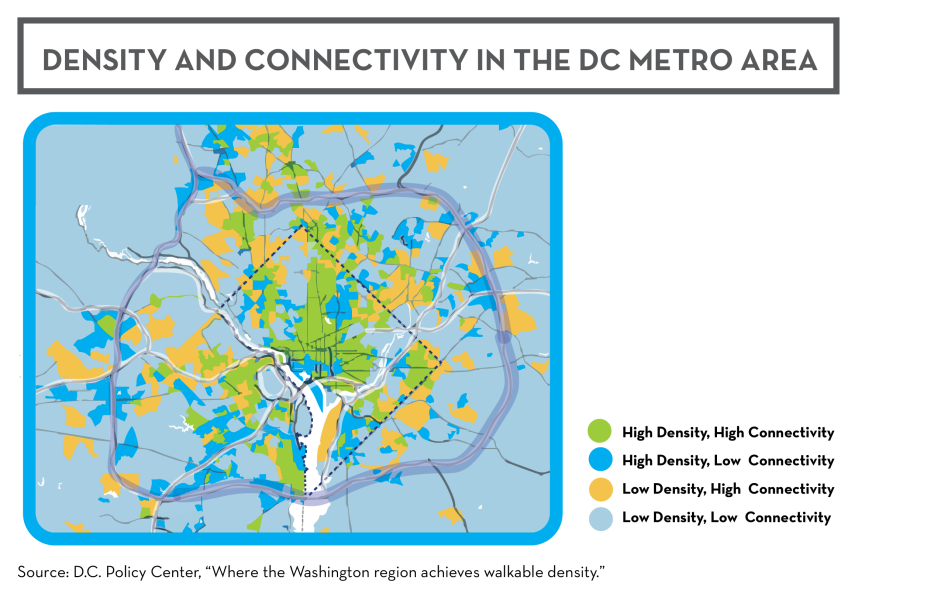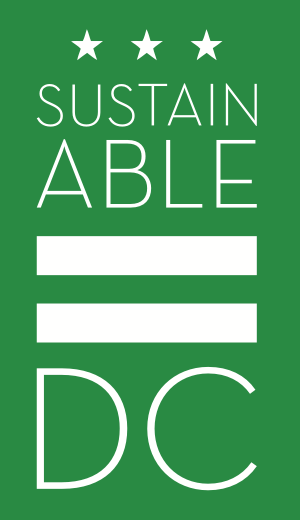

 The built environment includes all physical aspects of the environment where District residents live, work, and play including buildings, streets, recreation spaces, and other human-made infrastructure. All residents deserve these spaces to be healthy, safe, and affordable. While the District continues to develop and densify, it is paramount that the built environment not only meets the needs of residents but also prioritizes sustainability, equity, and resiliency. The District Government, through policies and programs that result in systemic changes, can shape the built environment to be one that leads to positive outcomes while being flexible enough to adapt to future changes.
The built environment includes all physical aspects of the environment where District residents live, work, and play including buildings, streets, recreation spaces, and other human-made infrastructure. All residents deserve these spaces to be healthy, safe, and affordable. While the District continues to develop and densify, it is paramount that the built environment not only meets the needs of residents but also prioritizes sustainability, equity, and resiliency. The District Government, through policies and programs that result in systemic changes, can shape the built environment to be one that leads to positive outcomes while being flexible enough to adapt to future changes.
Goal 1: Sustainably and equitably accommodate future population growth within the District
Status:  The average progress score of actions under this goal is between “Moderate Progress” (2 out of 4) and “Significant Progress” (3 out of 4). See annual progress reports for details.
The average progress score of actions under this goal is between “Moderate Progress” (2 out of 4) and “Significant Progress” (3 out of 4). See annual progress reports for details.
What's Been Done?
- The Housing Equity Report analyzed the current distribution of affordable housing and set area specific goals to deliver 12,000 affordable housing units across all planning areas by 2025, part of the bigger goal to create 36,000 new housing units also by 2025. In 2024, the District surpassed its goal of delivering 36,000 new homes by 2025.
- Several brownfields have been redeveloped or are in the process of being redeveloped, including Audi Field, Poplar Point, and Riggs Park.
- All Department of Housing and Community Development funded projects enforce compliance of the Green Building Design and Construction standards.
- The Department of Energy and Environment launched the Affordable Housing Retrofit Accelerator to provide direct technical and financial assistance to multifamily affordable housing buildings so they can meet the compliance requirements of the Building Energy Performance Standards.
What is Left to Do?
- Continue creating and preserving energy- and water-efficient affordable housing.
- Expand brownfield redevelopment incentives.
Goal 2: Strengthen existing neighborhoods to be vibrant and walkable while maintaining their historic character
Status:  The average progress score of actions under this goal is between “Initiated” (1 out of 4) and “Moderate Progress” (2 out of 4). See annual progress reports for details.
The average progress score of actions under this goal is between “Initiated” (1 out of 4) and “Moderate Progress” (2 out of 4). See annual progress reports for details.
What's Been Done?
- The District's Great Streets program offers competitive grants to support existing small businesses, attract new businesses, increase the District’s tax base, create new job opportunities for District residents, and transform emerging corridors into thriving and inviting neighborhood centers.
- The Office of Planning’s 2021 Comprehensive Plan was adopted by DC Council, which included a Future Land Use Map that increases housing density along high-capacity transit corridors.
- The District’s Housing in Downtown program provided a 20-year tax abatement for commercial-to-residential conversions, designed to catalyze new residential development and add thousands of new residents downtown.
What is Left to Do?
- Enhance programs to support businesses to open and operate in neighborhood commercial corridors.
- Encourage the development of affordable live-work units.
- Continue locating affordable, high-density housing close to commercial zones and high-capacity transit.
- Expand the Great Streets program to five streets east of the Anacostia River.
Goal 3: Improve the performance of existing buildings by reducing energy and water use, advancing health, and increasing livability
Status:  The average progress score of actions under this goal is “Moderate Progress” (2 out of 4). See annual progress reports for details.
The average progress score of actions under this goal is “Moderate Progress” (2 out of 4). See annual progress reports for details.
What's Been Done?
- The Healthy Homes program was established in 2012 and has addressed lead, mold, and other health hazards in hundreds of homes.
- The Department of General Services developed and published the Energy Management Plan on how to aggressively cut energy use of more than 25.7 million square feet of District government buildings.
- The Clean Energy DC Omnibus Amendment Act expanded resources for low‐income energy efficiency programs and established a Building Energy Performance Standard to drive energy improvements in existing buildings.
- Solar has been installed at several DC Housing Authority properties.
- The DC Sustainable Energy Utility offers training on energy efficiency and renewable energy design, construction, inspection, and maintenance.
- The DC Housing Authority performed a physical needs assessment of its housing portfolio, which included energy audits of properties, and made improvements to lower carbon emissions, reduce energy bills, and minimize wasteful water usage.
- The DC Building Energy Performance website hosts information about large buildings’ energy and water use and where they meet the Building Energy Performance Standard.
What is Left to Do?
- Continue rehabilitating public housing to be energy- and water-efficient.
- Continue developing a green building workforce by training built environment professionals and building operations staff in the latest green skills.
- Build public-private partnerships to expand best practices for building operations and maintenance.
- Retrofit and maintain all buildings owned by the District Government to reduce energy use by 50% and maximize the installation of renewable energy technology.
- Complete energy assessments of all District homes and buildings.
Goal 4: Ensure the highest standards of building performance and operation for all new construction, including net-zero energy use, while advancing health and overall livability
Status:  The average progress score of actions under this goal is between “Moderate Progress” (2 out of 4) and “Significant Progress” (3 out of 4). See annual progress reports for details.
The average progress score of actions under this goal is between “Moderate Progress” (2 out of 4) and “Significant Progress” (3 out of 4). See annual progress reports for details.
What's Been Done?
- The Department of Energy and Environment has provided grants to support early design assistance for projects committed to pursuing net‐zero energy.
- The Net-Zero Incentive Program supports project teams and owners to successfully design and build net-zero energy buildings.
- The Department of General services has delivered projects designed to net-zero energy standards, including Banneker Academic High School and West/John Lewis Elementary School.
- The District adopted the International Green Construction Code as a mandatory code.
What is Left to Do?
- Require higher levels of energy efficiency, renewable energy requirements, net-zero standards for new construction, and broader sustainability metrics for public projects.
- Provide incentives for new building projects to achieve net-zero energy.
- Incorporate sustainability best practices into neighborhood planning.
- Continuously adopt the latest green construction codes.
- By 2026, update the building energy codes to require that all new buildings achieve net-zero energy use or better.
Last updated: June 2025

